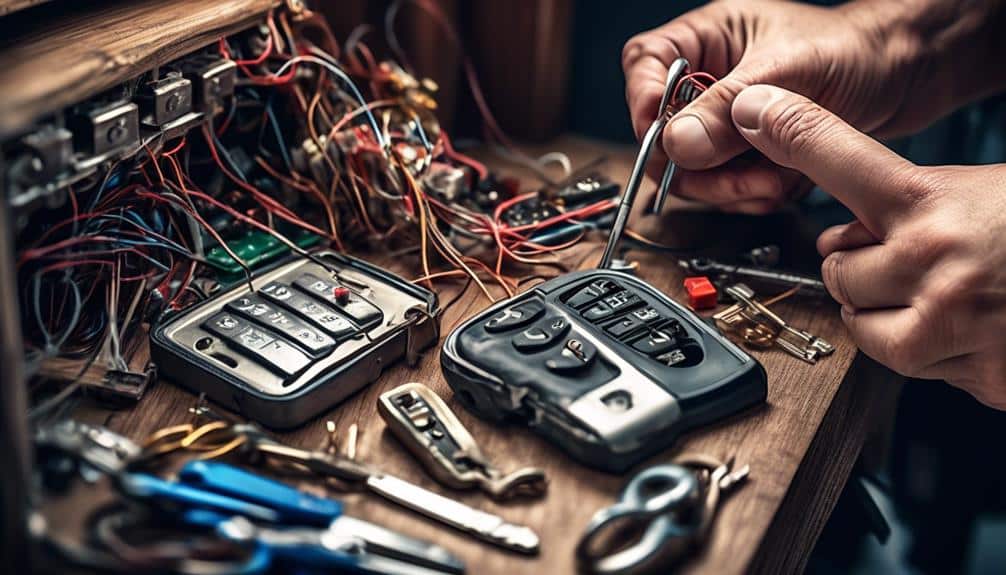Imagine coming home after a long day, only to find yourself locked out because your keyless entry system lock is malfunctioning. Frustrating, isn't it?
But fear not, because there are effective solutions available to help you fix this issue and regain access to your home or office. In this discussion, we will explore various troubleshooting techniques, do-it-yourself repair tips, and professional locksmith solutions that can come to your rescue.
So, whether you're a tech-savvy DIY enthusiast or prefer to leave it to the experts, we've got you covered. Stay tuned to learn how you can overcome the challenges of keyless entry system lock repair and ensure the security of your property.
Common Issues With Keyless Entry Locks
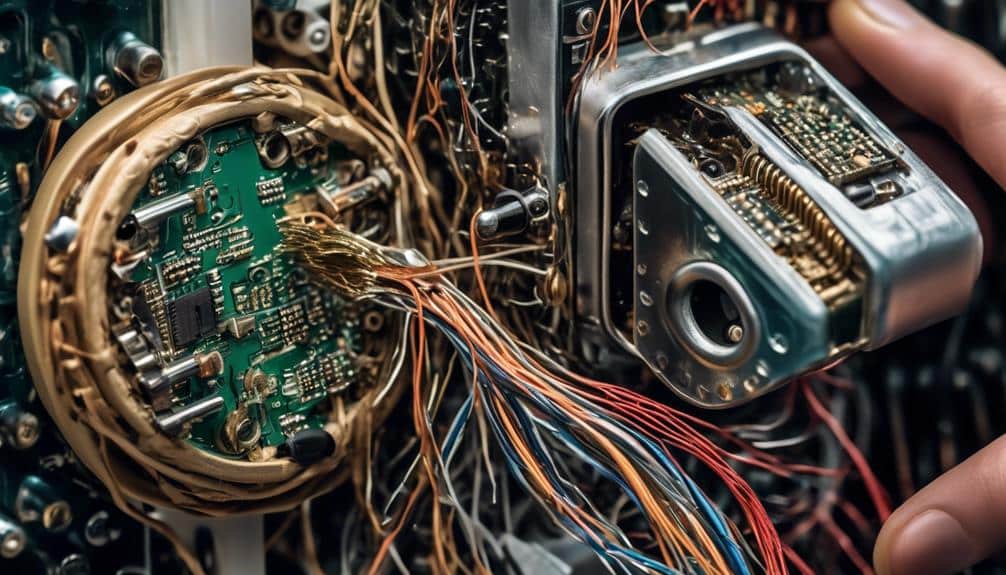
One common issue with keyless entry locks is a malfunctioning keypad, which can prevent you from entering your home or vehicle.
The keypad is a crucial component of a keyless entry lock system, as it allows you to input your unique access code and gain entry. However, over time, the keypad may experience wear and tear, leading to malfunctions.
There are several reasons why a keypad may malfunction. One possibility is that the buttons on the keypad become unresponsive or sticky due to dirt or debris accumulation. In such cases, simply cleaning the buttons with a soft cloth and a mild cleaning solution can often resolve the issue.
Another potential cause is a faulty connection between the keypad and the control panel. This can occur during the keyless entry lock installation process or due to wiring issues. In such cases, it's recommended to seek professional assistance to diagnose and repair the problem.
The benefits of keyless entry locks are numerous. They provide convenience, as you no longer need to carry around keys or worry about losing them. Additionally, keyless entry locks offer enhanced security, as they're more difficult to pick or tamper with compared to traditional locks. They also allow for easy access control, as you can easily change access codes when needed and grant temporary access to visitors or service providers.
Troubleshooting Keyless Entry Lock Problems
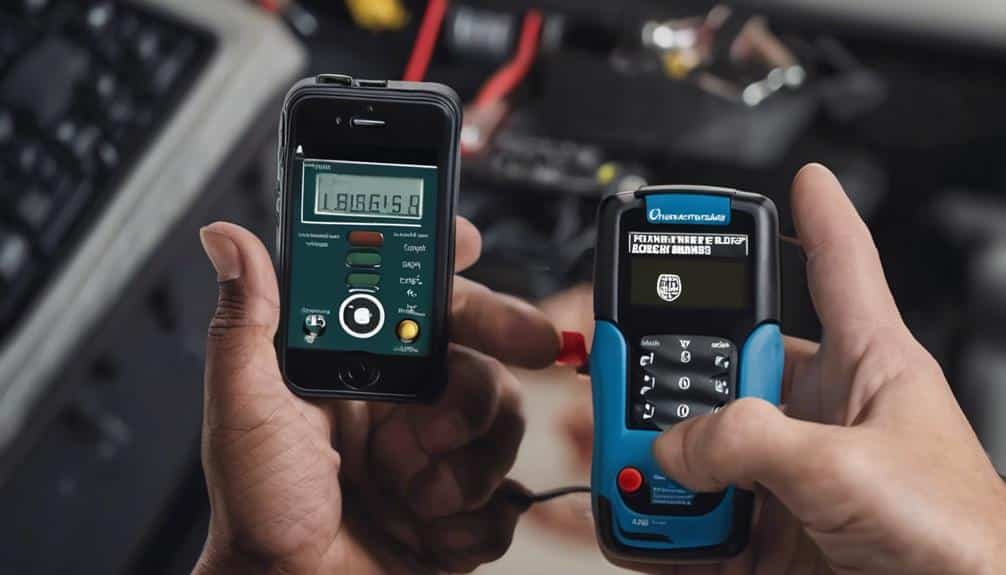
When troubleshooting keyless entry lock problems, it's important to be aware of common lock malfunctions such as unresponsive buttons or a non-functioning lock.
In some cases, resetting the keyless system may resolve the issue by clearing any temporary glitches.
Additionally, it's crucial to check and replace worn-out batteries as they can often be the cause of malfunctioning keyless entry locks.
Common Lock Malfunctions
To troubleshoot common lock malfunctions with keyless entry systems, start by thoroughly inspecting the exterior components and ensuring proper installation. Here are five key areas to check when troubleshooting keyless entry lock problems:
- Battery: Ensure the battery is correctly inserted and has enough power. Consider replacing the battery if necessary.
- Keypad: Check for any physical damage or debris that may be obstructing the buttons. Clean the keypad if necessary.
- Wiring: Inspect the wiring connections for any loose or damaged wires. Tighten or repair the connections as needed.
- Receiver: Test the receiver to ensure it's functioning properly. If not, consider replacing it.
- Programming: Verify that the lock is properly programmed and synced with the keyless entry system. Re-program if necessary.
Resetting the Keyless System
After thoroughly inspecting the exterior components and ensuring the proper installation of the keyless entry system lock, the next troubleshooting step is to reset the keyless system to resolve any lock problems. Resetting the keyless system is a simple yet effective solution that can help address issues such as unresponsive buttons, malfunctioning keypads, or system errors.
To reset the keyless system, follow these steps:
- Locate the reset button on the keyless entry system. The location of the reset button may vary depending on the model and manufacturer. Refer to the user manual for specific instructions.
- Press and hold the reset button for at least 10 seconds. This will reset the system and clear any stored data or settings.
- Release the reset button and wait for the keyless system to reboot. This may take a few seconds to a minute, depending on the system.
- Once the system has rebooted, test the keyless entry by pressing the buttons or entering the code on the keypad.
Resetting the keyless system is a quick and easy troubleshooting step that can often resolve common lock problems. However, if the issues persist, it may be necessary to consult a professional or contact the manufacturer for further assistance.
| Steps | Description |
|---|---|
| 1 | Locate the reset button on the keyless entry system |
| 2 | Press and hold the reset button for at least 10 seconds |
| 3 | Release the reset button and wait for the system to reboot |
| 4 | Test the keyless entry system for functionality |
Replacing Worn-Out Batteries
To troubleshoot keyless entry lock problems, one of the first steps is to replace worn-out batteries in the system. The keyless entry lock relies on battery power to function properly, and over time, the battery life can diminish, leading to various issues. Here are some signs that indicate a dying keyless entry lock battery:
- Diminished range: If you notice that you need to be closer to the lock for it to respond, it could be a sign that the battery is running low.
- Slow response time: A dying battery can cause delays in the lock's response, making it take longer to unlock or lock the door.
- Inconsistent operation: If the lock works intermittently or only responds occasionally, it may be due to a weak battery.
- Low battery warning: Some keyless entry locks have a battery indicator that will notify you when the battery is low.
- Failed lock operation: When the battery is completely drained, the lock may fail to operate altogether.
When you encounter any of these signs, it's crucial to replace the worn-out battery promptly to ensure the smooth functioning of your keyless entry lock system.
DIY Keyless Entry Lock Repair Techniques
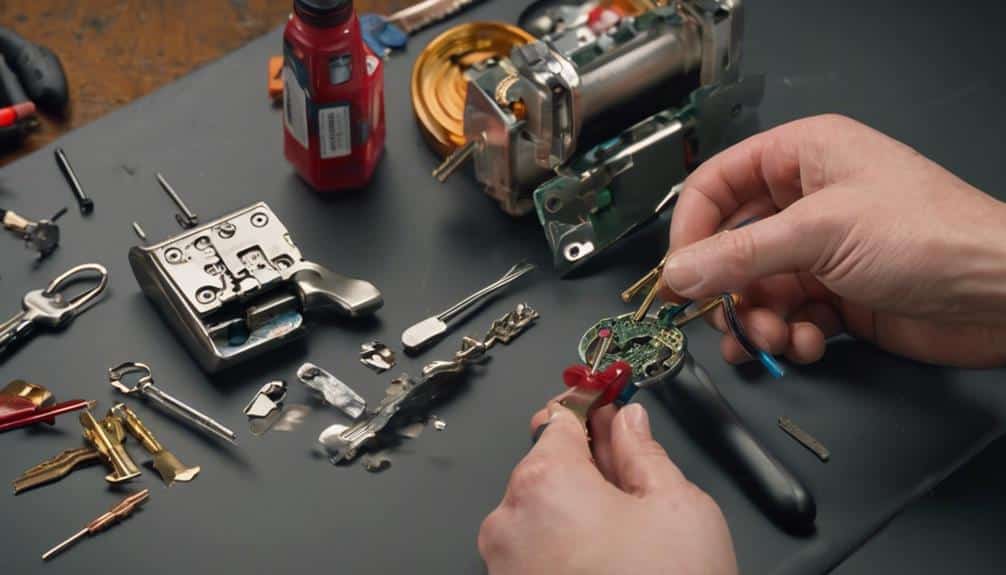
Now let's talk about some DIY techniques to repair keyless entry locks.
First, we'll cover troubleshooting common issues that may arise with these locks.
Then, we'll discuss how to replace the batteries and keys in order to ensure smooth operation of the lock.
Troubleshooting Common Issues
If you're experiencing common issues with your keyless entry system lock, there are several DIY repair techniques you can try to troubleshoot and resolve the problems. Here are some steps you can take to diagnose and fix the issues:
- Check the batteries: Make sure the batteries in your key fob aren't dead or low. Replace them if necessary.
- Reprogram the key fob: Sometimes, the key fob may lose its programming. Follow the manufacturer's instructions to reprogram it.
- Clean the keyless entry pad: Dirt and debris can interfere with the functionality of the keyless entry pad. Clean it thoroughly using a soft cloth and a mild cleaner.
- Reset the system: Resetting the keyless entry system can often resolve any glitches. Consult the user manual to find out how to do this.
- Seek professional help: If all else fails, it may be time to call a professional locksmith or the manufacturer for assistance.
Replacing Batteries and Keys
For DIY keyless entry lock repair techniques, one important step is to replace the batteries and keys. This is especially crucial if you are experiencing remote control malfunction or if the lock is not responding to your commands. To ensure a smooth replacement process, it is essential to follow the manufacturer's instructions and use compatible batteries and keys. Here is a table to guide you:
| Steps to Replace Batteries and Keys |
|---|
| Step 1: Gather the necessary tools and replacement batteries and keys. |
| Step 2: Locate the battery compartment on the lock and open it. |
| Step 3: Remove the old batteries and replace them with new ones, ensuring correct polarity. |
| Step 4: If necessary, reprogram the lock's codes according to the manufacturer's instructions. |
| Step 5: Replace the old keys with new ones, if needed. |
| Step 6: Test the lock to verify that the batteries and keys have been successfully replaced. |
Keyless Entry Lock Maintenance Tips
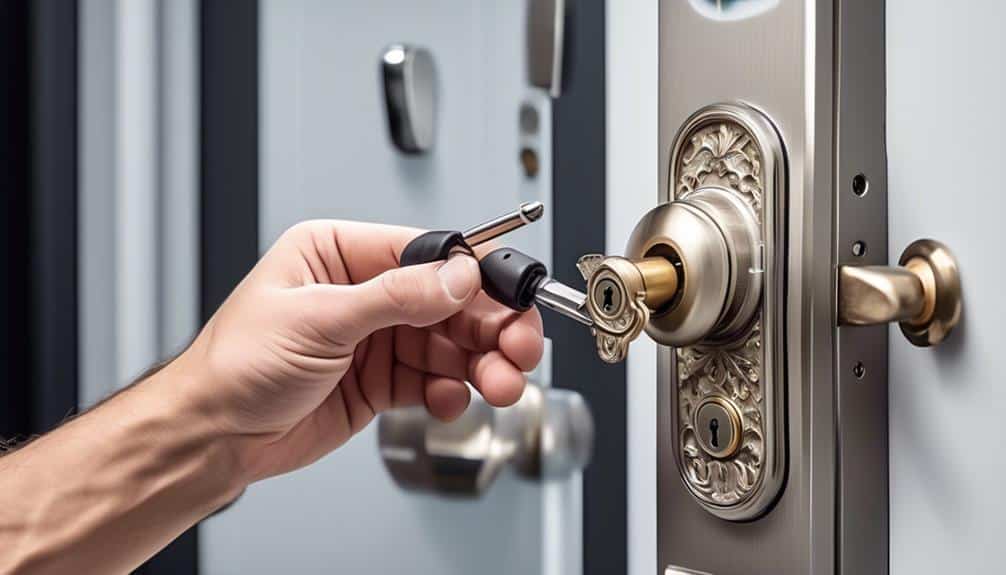
Regular maintenance is essential for ensuring the proper functioning of your keyless entry lock system. By following these keyless entry lock maintenance tips, you can prolong the life of your system and avoid potential issues:
- Clean the keypad: Dust, dirt, and debris can accumulate on the keypad, affecting its responsiveness. Regularly clean the keypad with a soft cloth or a mild cleaning solution to keep it in optimal condition.
- Inspect the batteries: Check the batteries of your keyless entry lock regularly to ensure they have enough power. Replace them if needed to prevent any interruption in the system's operation.
- Check for loose connections: Over time, the connections between the keypad and the lock mechanism may become loose. Regularly inspect and tighten any loose connections to maintain a secure and reliable system.
- Lubricate the lock mechanism: Apply a small amount of graphite lubricant to the lock mechanism to ensure smooth operation. Avoid using oil-based lubricants as they can attract dust and debris, leading to potential malfunctions.
- Test the system periodically: Regularly test your keyless entry lock system to ensure all the buttons and functions are working correctly. This will help you identify any potential issues and address them promptly.
Professional Locksmith Solutions for Keyless Entry Locks
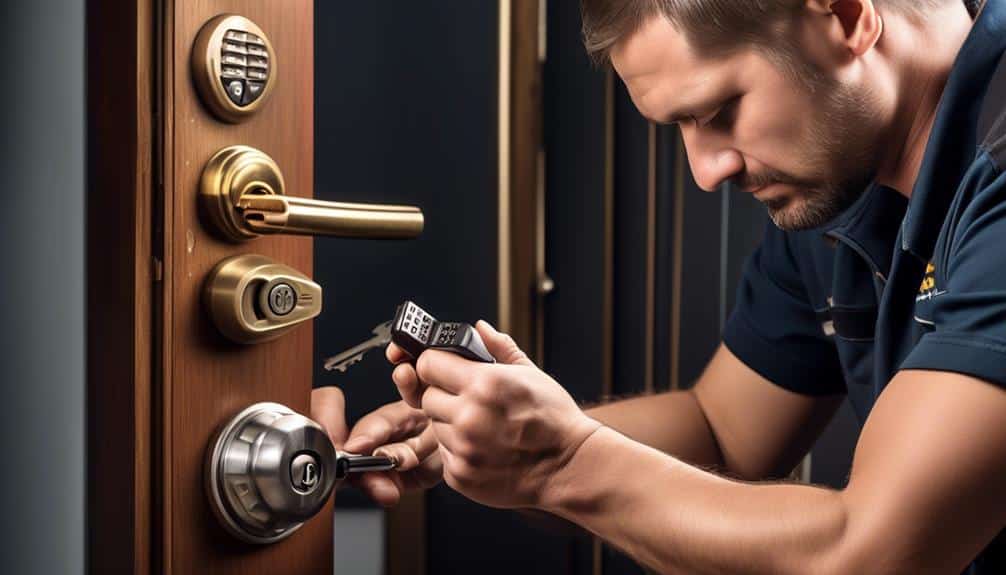
To ensure optimal functioning and address any issues with your keyless entry lock system, professional locksmiths offer a range of solutions. When it comes to keyless entry lock installation, these experts possess the knowledge and expertise to handle the task efficiently. They can guide you through the process, helping you choose the right lock for your needs and ensuring it's installed correctly.
In addition to installation, professional locksmiths can also enhance the security features of your keyless entry lock. They can provide recommendations and upgrades to ensure that your lock is resistant to tampering and unauthorized access. This may include adding additional layers of encryption, implementing multi-factor authentication, or integrating it with a comprehensive security system.
If you experience any issues with your keyless entry lock, a professional locksmith can diagnose and repair the problem. They have the necessary tools and skills to troubleshoot and fix any technical glitches or malfunctions. Whether it's a faulty keypad, a malfunctioning sensor, or a broken lock mechanism, they can identify the root cause and provide an effective solution.
Upgrading and Enhancing Keyless Entry Lock Systems
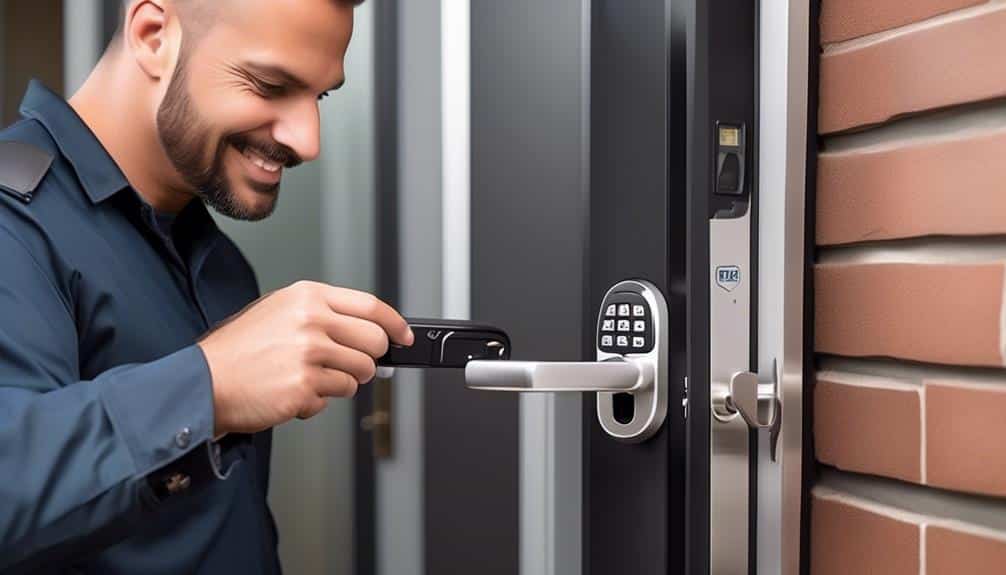
Consider upgrading and enhancing your keyless entry lock system to further improve the security and convenience of your home or business. Upgrading security features and adding smart home integration can provide you with advanced capabilities and peace of mind.
Here are five ways you can enhance your keyless entry lock system:
- Biometric Access Control: Upgrade to a system that uses fingerprint or facial recognition technology for even stronger security.
- Remote Monitoring and Control: Gain the ability to control and monitor your keyless entry lock system remotely through a smartphone app or computer.
- Voice Activation: Integrate your keyless entry lock system with voice assistants like Amazon Alexa or Google Assistant for hands-free access control.
- Two-Factor Authentication: Enhance security by requiring multiple methods of verification, such as a PIN code and a fingerprint scan.
- Activity Logging: Keep track of who enters and exits your property by adding an activity logging feature to your keyless entry lock system.
Frequently Asked Questions
How Do I Program a New Keyless Entry Code for My Lock?
To program a new keyless entry code for your lock, start by locating the programming button on your keyless entry system. Press and hold the button until the system enters programming mode.
Then, enter your desired code using the keypad and press the programming button again to save the new code.
If you encounter any issues, such as the code not being accepted or the keypad not working properly, refer to the troubleshooting section in the user manual for common keyless entry lock issues.
What Should I Do if My Keyless Entry Lock Is Not Responding to the Keypad?
If your keyless entry lock isn't responding to the keypad, there are a few keyless entry lock troubleshooting steps you can try.
First, check the batteries and replace them if necessary.
Next, make sure the keypad is clean and free from any dirt or debris.
If the problem persists, you may need to reset the keyless entry lock. Refer to the manufacturer's instructions on how to reset a keyless entry lock for proper guidance.
Can I Install a Keyless Entry Lock on My Own, or Do I Need to Hire a Professional?
Installing a keyless entry lock on your own is possible, but it can be a complex process. It involves understanding the wiring and programming of the lock system. If you aren't confident in your technical skills, it's recommended to hire a professional locksmith.
They have the expertise to install the lock correctly, ensuring it functions properly and provides the security you need. Hiring a locksmith will give you peace of mind and save you time and potential frustration.
Are Keyless Entry Locks More Susceptible to Hacking or Unauthorized Access?
Keyless entry locks can indeed be vulnerable to hacking or unauthorized access. However, there are effective measures you can take to enhance the security of your keyless entry system.
By regularly updating the firmware and software, using strong and unique passwords, and enabling two-factor authentication, you can significantly reduce the risk.
Additionally, implementing physical security measures such as installing a deadbolt lock can provide an extra layer of protection.
Stay vigilant and follow these tips to safeguard your keyless entry system from potential vulnerabilities.
What Are the Benefits of Upgrading to a Smart Keyless Entry Lock System?
Upgrading to a smart keyless entry lock system offers several benefits.
With a smart lock, you can easily unlock your door using a keypad or your smartphone, eliminating the need for keys. This enhances convenience and eliminates the risk of losing or forgetting your keys.
Additionally, smart locks often come with advanced security features such as encryption and two-factor authentication, making them more secure than traditional locks.
With a smart keyless entry lock system, you can enjoy improved convenience and enhanced security for your home or business.

